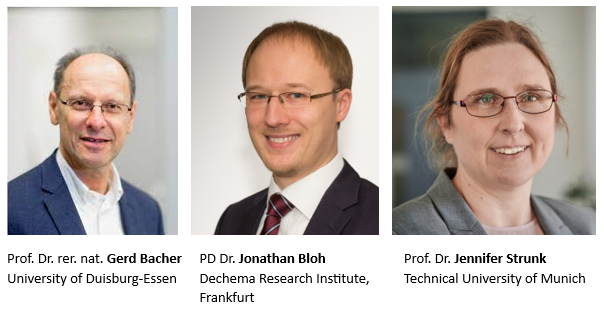Gas-solid photocatalytic oxidation of dinitrogen to nitrogen oxides: Mechanism and kinetics
Gerd Bacher, University of Duisburg-Essen; Jonathan Bloh, Dechema Research Institute, Frankfurt; Jenifer Strunk, Technical University of Munich
The aim of the project is to attain a detailed understanding of the photocatalytic oxidation of N2 to nitrogen oxides in a gas-solid reaction. This recently discovered intriguing reaction could enable a completely new way for the sustainable synthesis of nitrates to be used for instance as (solar) fertilizers. Conducting the reaction in the gas phase has the significant advantage that the water-to-nitrogen ratio can be precisely controlled, suppressing the unwanted water oxidation and reduction as side-reactions. However, there is currently little knowledge of this reaction so this project will lay the foundation of a detailed mechanistic and kinetic understanding. This challenging goal thus requires complementary expertise from spectroscopy, catalysis, and reaction engineering working in concert.The first objective towards this end is to fully close the reaction’s material balance by identifying all reaction partners and products, including those of the corresponding reduction reaction. This will enable us to properly set up analytics and develop a screening protocol for routine evaluation of photocatalyst materials. As a systematic study on the topic is currently missing, suitable co-catalysts for nitrogen oxidation will be identified by systematically grafting metal ions (V, Mo, W, Fe, Pd, Pt, Cu) and oligomers onto TiO2, and evaluation of their photocatalytic activity. The metals are chosen based on proven catalytic activity in either the nitrogen oxidation or the decomposition of NO as the reverse reaction. TiO2 will be used as it has proven photocatalytic activity for this reaction and thereby suitable optoelectronic properties.The core objective is to unravel both, the mechanism, and the kinetics of the reaction in dependence of the employed reaction conditions (e.g., temperature, gas phase composition, and light intensity) . Using in situ and time-resolved laser spectroscopy, both the charge-carrier dynamics inside the semiconductor and their interaction with the catalytic sites will be interrogated. Raman and infrared spectroscopy are used to probe the surface of the catalyst and identify intermediate species and adsorption behavior. This information will be linked with data on the reaction rate and formed products to obtain a holistic mechanistic and kinetic model as foundation for future studies.

